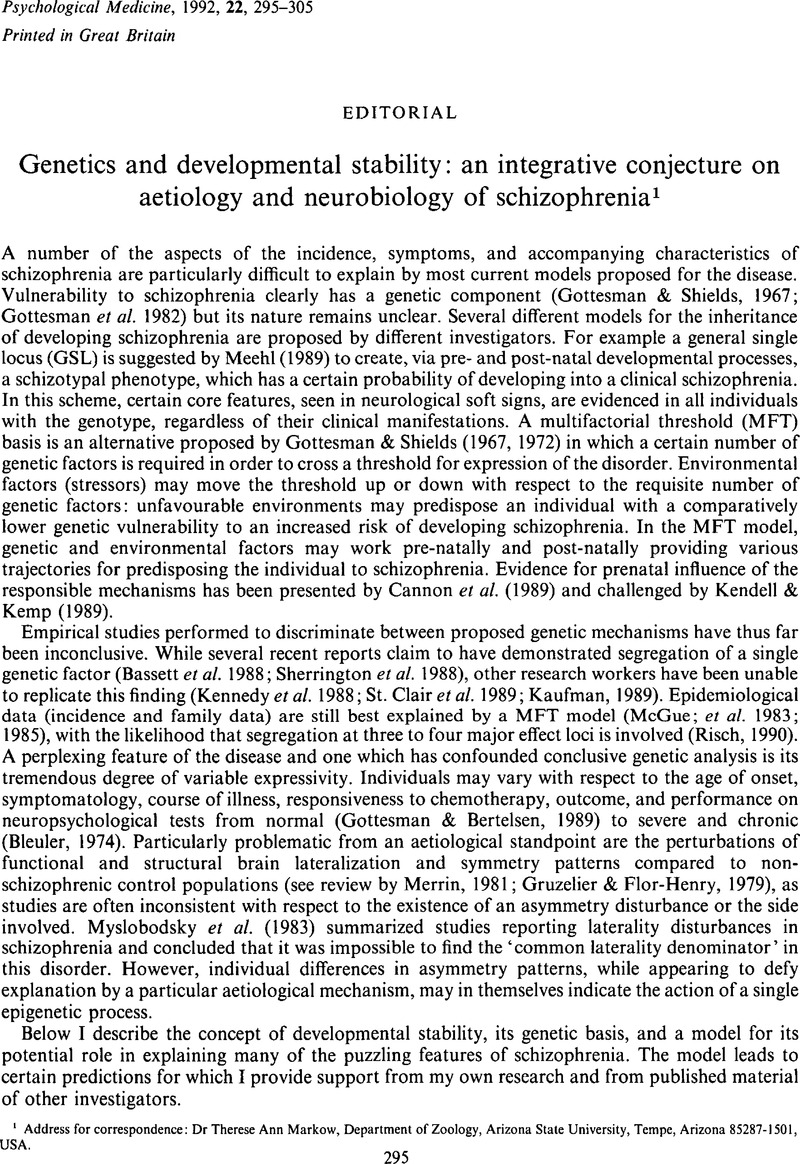Crossref Citations
This article has been cited by the following publications. This list is generated based on data provided by Crossref.
Markow, T. A.
1992.
Human handedness and the concept of developmental stability.
Genetica,
Vol. 87,
Issue. 2,
p.
87.
Yeo, Ronald A.
and
Gangestad, Steven W.
1993.
Developmental origins of variation in human hand preference.
Genetica,
Vol. 89,
Issue. 1-3,
p.
281.
1993.
Can classic hypotheses be interpreted within a neurodevelopmental framework?.
The Lancet,
Vol. 341,
Issue. 8844,
p.
534.
Yeo, Ronald A.
Gangestad, Steven W.
and
Daniel, Walter F.
1993.
Hand preference and developmental instability.
Psychobiology,
Vol. 21,
Issue. 2,
p.
161.
Kovach, Joseph K.
1993.
Sources of behavioral deviation modeled by early color preferences in quail. III. Developmental stability and normative canalization.
Behavior Genetics,
Vol. 23,
Issue. 4,
p.
369.
Polak, Michal
and
Trivers, Robert
1994.
The science of symmetry in biology.
Trends in Ecology & Evolution,
Vol. 9,
Issue. 4,
p.
122.
Mant, R.
Williams, J.
Asherson, P.
Parfitt, E.
McGuffin, P.
and
Owen, M. J.
1994.
Relationship between homozygosity at the dopamine D3 receptor gene and schizophrenia.
American Journal of Medical Genetics,
Vol. 54,
Issue. 1,
p.
21.
Gangestad, Steven W.
Thornhill, Randy
and
Yeo, Ronald A.
1994.
Facial attractiveness, developmental stability, and fluctuating asymmetry.
Ethology and Sociobiology,
Vol. 15,
Issue. 2,
p.
73.
Fraser, F. Clarke
1994.
Developmental Instability: Its Origins and Evolutionary Implications.
Vol. 2,
Issue. ,
p.
319.
Yeo, Ronald A.
and
Gangestad, Steven W.
1994.
Developmental Instability: Its Origins and Evolutionary Implications.
Vol. 2,
Issue. ,
p.
283.
McGrath, J.J.
van Os, J.
Hoyos, C.
Jones, P.B.
Harvey, I.
and
Murray, R.M.
1995.
Minor physical anomalies in psychoses: associations with clinical and putative aetiological variables.
Schizophrenia Research,
Vol. 18,
Issue. 1,
p.
9.
O'Callaghan, Eadbhard
Buckley, Peter
Madigan, Cathy
Redmond, Oonagh
Stack, John P.
Kinsella, Anthony
Larkin, Conall
Ennis, Joseph T.
and
Waddington, John L.
1995.
The relationship of minor physical anomalies and other putative indices of developmental disturbance in schizophrenia to abnormalities of cerebral structure on magnetic resonance imaging.
Biological Psychiatry,
Vol. 38,
Issue. 8,
p.
516.
Bullmore, E.
Brammer, M.
Harvey, I.
Murray, R.
and
Ron, M.
1995.
Cerebral hemispheric asymmetry revisited: effects of handedness, gender and schizophrenia measured by radius of gyration in magnetic resonance images.
Psychological Medicine,
Vol. 25,
Issue. 2,
p.
349.
Annett, Marian
1996.
In Defence of the Right Shift Theory.
Perceptual and Motor Skills,
Vol. 82,
Issue. 1,
p.
115.
Murphy, Kieran C.
and
Owen, Michael J.
1996.
Minor Physical Anomalies and their Relationship to the Aetiology of Schizophrenia.
British Journal of Psychiatry,
Vol. 168,
Issue. 2,
p.
139.
THORNHILL, RANDY
and
MØLLER, ANDERS PAPE
1997.
DEVELOPMENTAL STABILITY, DISEASE AND MEDICINE.
Biological Reviews,
Vol. 72,
Issue. 4,
p.
497.
Møller, Anders Pape
1997.
Developmental Stability and Fitness: A Review.
The American Naturalist,
Vol. 149,
Issue. 5,
p.
916.
Polak, Michal
1997.
Parasites and Pathogens.
p.
246.
Furlow, Bryant
Gangestad, Steven W.
and
Armijo-Prewitt, Tara
1998.
Developmental stability and human violence.
Proceedings of the Royal Society of London. Series B: Biological Sciences,
Vol. 265,
Issue. 1390,
p.
1.
1999.
Book Review.
Laterality: Asymmetries of Body, Brain and Cognition,
Vol. 4,
Issue. 4,
p.
389.



